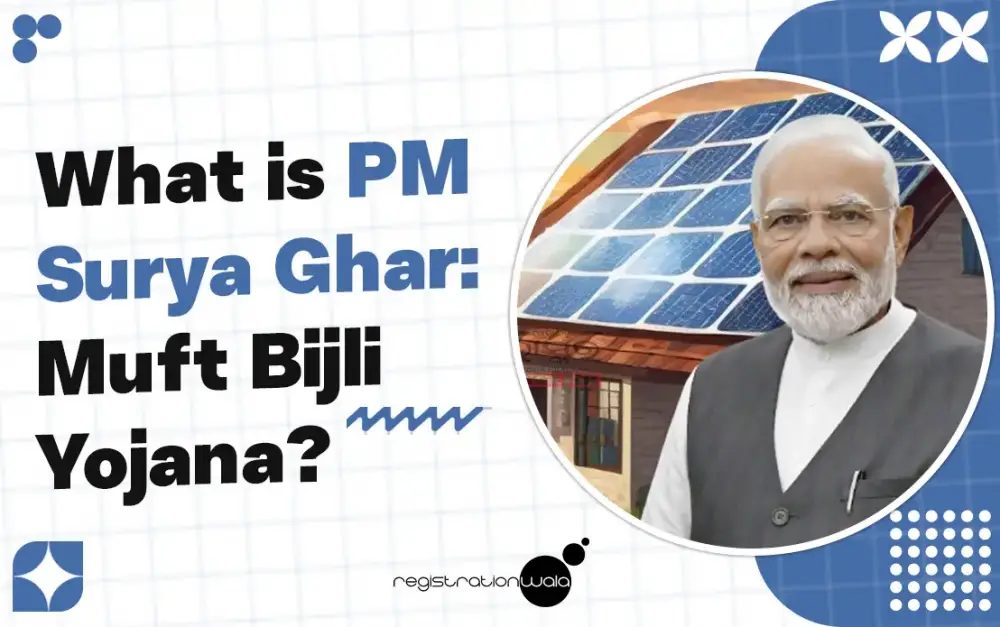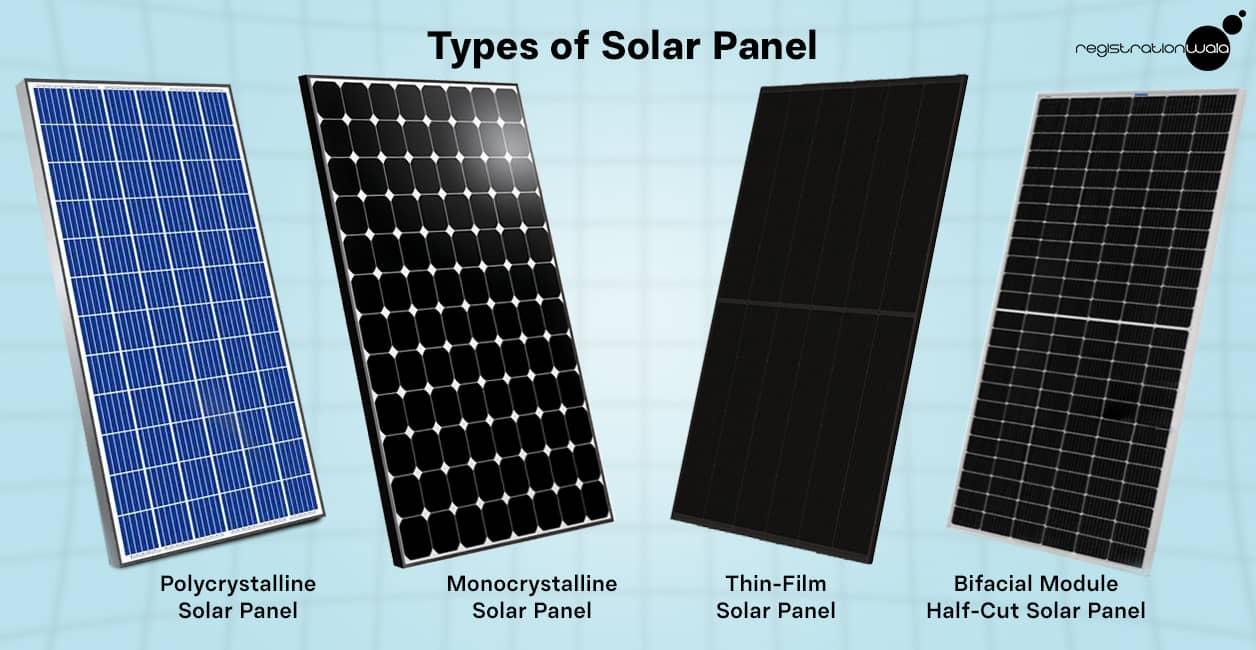What is PM Surya Ghar: Muft Bijli Yojana?
- February 16, 2024
- Registrationwala

- Home
- /
- Knowledge Base
- /
- News & other businesses
- /
- Blog
- /
- What is PM Surya Ghar: Muft Bijli Yojana?
What is PM Surya Ghar: Muft Bijli Yojana?
PM Surya Ghar: Muft Bijli Yojana is a scheme launched by the Government of India recently. It aims to encourage people to apply for installation of solar panels on their rooftops. This scheme was first mentioned by the Finance Minister Nirmala Sitharaman while announcing the Interim Budget, 2024-25. Under this scheme, the Government of India will provide up to 300 units of free electricity every month. According to PM Narendra Modi, the project would entail an investment of over Rs 75,000 crore. This scheme is an effort towards promoting green energy.
Solar Energy and Solar Panels
Meaning, History & Leaders
Solar energy is sun energy, i.e., the power which comes from the sun. This power gets converted into electrical energy for daily use at larger capacities by many people around the world through solar panels. It is eco-friendly and helps to decrease global warming and ozone holes.
The development of solar energy goes back more than 100 years. Solar energy was used primarily for the production of steam which then be used to drive machinery in the early days. But it wasn’t until Edmond Becquerel discovered the photovoltaic effect that would allow the conversion of sunlight to solar electric energy. After his discovery, Charles Fritts in 1893 invented the first genuine solar cell which was formed by coating sheets of selenium along with a thin gold layer. And from this humble beginning arose the device we know today as the Solar Panel.
An American inventor known as Russel Ohl, under the payroll of Bell Laboratories, patented the world’s first silicon solar cell in 1941. His invention led to the production of the first solar panel 1954 by the same company he worked for. Solar panels in the solar cells are being used in calculators and also to provide solar power to entire homes and commercial buildings, such as Google’s headquarters located in California.
Top 10 Countries That Produce the Most Solar Power (Megawatts, 2021):
|
Country |
Capacity |
|
China |
393,032 |
|
United States |
113,015 |
|
Japan |
78,833 |
|
Germany |
66,554 |
|
India |
63,146 |
|
Australia |
26,792 |
|
Italy |
25,083 |
|
Brazil |
24,079 |
|
Netherlands |
22,590 |
|
South Korea |
20,975 |
How it Functions & Types
Solar panels gather renewable energy in the form of sunlight and convert it into electricity which can be utilized for providing power for electrical loads. Solar panels contain multiple individual solar cells which are composed of silicon, phosphorus (to provide negative charge), and boron (to provide positive charge) layers. Solar panels give rise to electric current by absorbing the photons. The resulting energy generated allows electrons to be knocked out of their atomic orbits after which they are released into the electric field. This electric field is generated by the solar cells which then pull these free electrons into a directional current. This entire process is called Photovoltaic Effect.
There is more than enough roof area in an average house for installation of the required number of solar panels to generate solar electricity which can be supplied for all of its power needs. The excess generated electricity goes onto the main power grid which pays off in electricity use at night. In off-grid setups, essential components such as battery banks, charge controller and inverters are utilized. The solar array sends direct current (DC) electricity through the charge controller to the battery bank. Afterwards, the DC gets converted to alternating current (AC) that can be used for non-DC appliances. With the assistance of inverters, solar panel arrays can be sized to meet diverse electrical load requirements. AC can be used to power loads in houses, commercial buildings, cottages, oil and gas flow monitoring, recreational vehicles, boats and more.
There are generally 4 types of Solar Panels:

Advantages and disadvantages of these solar panels are mentioned below:
|
Solar Cell Type |
Efficiency Rate (%) |
Advantages |
Disadvantages |
|
Monocrystalline Solar Panels |
Approx. 20% |
High efficiency rate; ideal for commercial use; high life-time value |
Expensive |
|
Polycrystalline Solar Panels |
Approx. 15% |
Lower price |
Sensitive to high temperatures; lower lifespan & slightly less space efficiency |
|
Thin-Film: Amorphous Silicon Solar Panels |
Approx. 7-10% |
Relatively low costs; easy to produce as well as flexible |
Shorter warranties & lifespan |
|
Concentrated PV Cell |
Approx. 41% |
Very high performance & efficiency rate |
Solar tracker & cooling system required to achieve high efficiency rate |
Benefits of PM Surya Ghar: Muft Bijli Yojana
1.jpg)
Benefits of getting solar panels installed on rooftops of houses under the PM Surya Ghar: Muft Bijlib Yojana:
- Solar panels can significantly reduce or even eliminate electricity costs since the electricity generated by sunlight is free.
- Solar panels make use of green energy, reducing reliance on fossil fuels and decreasing carbon footprint. So it is good for the environment.
- Government will provide subsidies to residential households for solar panels.
- Low maintenance is required for the solar panels and they have a long lifespan which generally ranges from 25 to 30 years.
- They can also increase property value and help get buyers faster since people value energy efficiency and reduced utility costs.
PM Surya Ghar Yojana Eligibility Criteria
Those who want to avail the benefits of PM Surya Ghar: Muft Bijli Yojana need to be eligible for it. The eligibility criteria for this scheme is mentioned below:
- The family’s annual income should not exceed Rs 1.5 lakhs.
- Applicant’s family should not have a government employee.
- This scheme is not limited to one caste or community, so anyone who is eligible can avail it.
- It is mandatory for Aadhar card to be linked to the bank account to avail the scheme’s benefits.
- The applicant should have the citizenship of India.
What are the documents required for PM Surya Ghar Yojana?
The various kinds of documents which are needed to apply for this scheme are mentioned below:
- Proof of Residence
- Aadhaar card details
- Certificate of income
- Electricity bill
- Ration card
- Mobile number
- Passport size photograph
- Bank account passbook
How to apply for PM Surya Ghar: Muft Bijli Yojana?
Under this scheme, the solar panels will be fixed on top of a building, home or a residential property. If you’re interested in applying for this scheme, just follow the steps mentioned below:
- To apply for this scheme, you have to visit the national portal of PM Surya Ghar: Muft Bijli Yojana which is https://pmsuryaghar.gov.in.
- After the link opens, you need to click on Apply for Rooftop Solar and register in the portal with the details mentioned below:
- Select your State
- Select your Electricity Distribution Company
- Fill in your Electricity Consumer Number.
- Enter your Contact number
- Enter your Email
- Once the registration is done successfully, the customer has to login with a consumer number and mobile number. And then apply for the rooftop solar as per the form.
- After this step is done, the customer has to wait until their forms get approved. Once the approval is given, you have to get the plant installed by any of the registered vendors in DISCOM (Distribution Company).
- Once installation is completed, you have to submit the plant details and apply for a net meter.
- Commissioning certificate will be generated from the portal, after installation of net meter and inspection by DISCOM.
- Once you get the commissioning report, you will be required to submit the bank account details and a canceled cheque through the portal.
- You will receive the subsidy in their bank accounts within 30 days.
Subsidy for Residential Households
- A subsidy of Rs 30,000/- per kW up to 2 kW
- A subsidy of Rs 18,000/- per kW for additional capacity up to 3 kW
- A total Subsidy for systems larger than 3 kW capped at Rs 78,000/
|
Average Monthly Electricity Consumption (units) |
Suitable Rooftop Solar Plant Capacity |
Subsidy Support |
|
0-150 |
1 – 2 kW |
Rs 30,000 to Rs 60,000/ |
|
150-300 |
2 – 3 kW |
Rs 30,000 to Rs 60,000/ |
|
>300 |
Above 3 kW |
Rs 78,000/ |
Conclusion
PM Surya Ghar: Muft Bijli Yojana aims to offer citizens numerous benefits, including significant cost savings, enhanced energy independence, and relief to the environment from air pollution. Since the poor sections will get subsidies as per the scheme, they can utilize that money for their essential needs. As the world is shifting towards clean and green energy, India is also making efforts to do the same whether it’s through this scheme or by launching electronic vehicles every now and then. The efforts by GOI and top players of the renewable energy industry like Adani and Tata are helping India to meet the sustainable goals. This new scheme not only addresses the immediate needs of millions but is also anticipated to drive our nation towards energy self-sufficiency.
Frequently Asked Questions (FAQs)
Q1. How much time would it take to get the subsidy?
A. You will get the subsidy from the Government within 30 days of the application.
Q2. What is the PM Surya Ghar: Muft Bijli Yojana?
A. PM Surya Ghar: Muft Bijli Yojana is an initiative by the Government of India. Through this initiative, GOI plans to provide free electricity up to 300 units every month to the people who are eligible. The purpose of this initiative is to encourage the use of clean and renewable energy by installing solar panels on housing rooftops. Since the scheme is for the weaker sections of the society, they will save up a lot of money on electricity and can utilize money saved for fulfilling other essential needs.
Q3. Will I get constant energy from the rooftop solar panel all year round?
A. No, the daily energy generation from the rooftop solar panel can vary throughout the year due to several factors such as the intensity of the sunlight, weather patterns, and the angle of the sunlight hitting the solar panels. On cloudy days, the solar panels will produce less energy.
Q4. What targets has the government kept for installation of rooftop solar plants in the country?
A. The Government of India has set the target of installing 40,000 MW of rooftop solar (RTS) power by the year of 2026.
Q5. What is DISCOM?
A. Discom stands for 'Distribution Company'. Discoms are responsible for the distribution of electricity to the consumers.
Q6. Who is eligible for this scheme?
A. To be eligible for this scheme, the applicant should be the citizen of India. His family’s annual income should not exceed Rs 1.5 lakhs and his family should not have a government employee. It is mandatory for Aadhar card to be linked to the bank account to avail the scheme’s benefits.
- 5702 views
